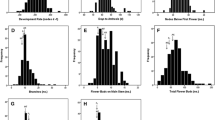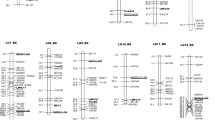Abstract.
AFLP mapping in Petunia hybrida was undertaken with the intention of building a high-density genetic map suitable for applications such as map-based gene cloning. In total five maps were constructed from two mapping populations, with placement of more than 800 markers. Despite the large number of markers the resulting map is roughly ten-fold smaller than those of other plant species, including the closely related tomato. Low levels of recombination are reflected in clusters of tightly linked markers, both AFLPs and RFLPs, in all the maps. Clustering patterns vary between mapping populations, however, such that loci tightly linked in one population may be separable in another. Combined with earlier reports of aberrant meiotic pairing and recombination, our results suggest that, for species like petunia, map-based cloning may be more complex than in model species such as arabidopsis and tomato.
Similar content being viewed by others
Author information
Authors and Affiliations
Additional information
Electronic Publication
Rights and permissions
About this article
Cite this article
Strommer, .J., Peters, .J., Zethof, .J. et al. AFLP maps of Petunia hybrida: building maps when markers cluster. Theor Appl Genet 105, 1000–1009 (2002). https://doi.org/10.1007/s00122-002-1009-y
Received:
Accepted:
Issue Date:
DOI: https://doi.org/10.1007/s00122-002-1009-y




